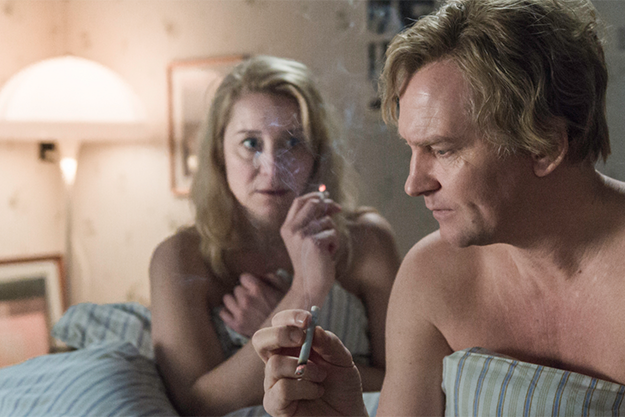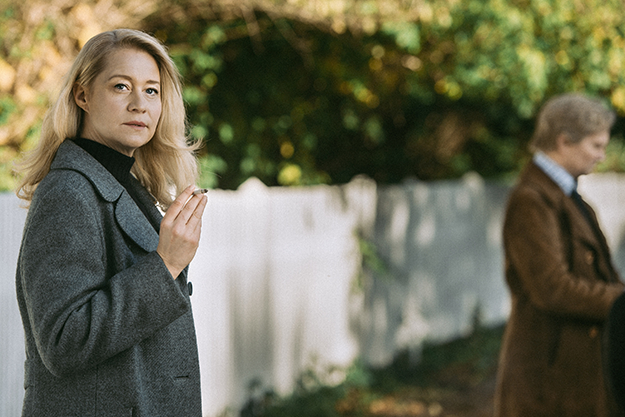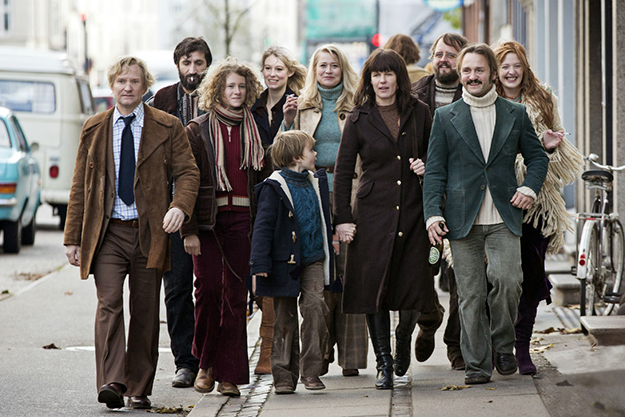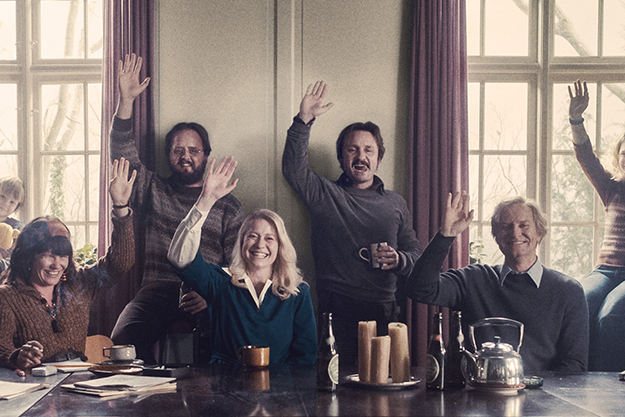Berlin Interview: Thomas Vinterberg
There’s a painful scene in The Commune, the latest feature from Danish filmmaker Thomas Vinterberg, in which Anna suggests that her husband’s new (and much younger) lover, Emma, should move into the oversized house the two share with their fellow commune members. “Bring her, we’ll work something out,” she says at the dinner table with a smile that’s clearly killing her. Reuniting with co-writer Tobias Lindholm, who also helped write the scripts for Submarino (10) and The Hunt (12), Vinterberg draws from his own experience growing up on a commune in the 1970s to expose the way group dynamics can so easily destroy the individual.
Erik (Ulrich Thomsen) and Anna (Trine Dyrholm) are both respected professionals—an architecture professor and news reporter, respectively—and when they inherit a giant house in Copenhagen, Anna encourages her husband to fill its echoing chambers with a selection of friends and strays who share their intellectual inclinations. All decisions are made through group consensus, and rent is paid according to income. The arrangement certainly seems ideal, and the film opens under the guise of a light-hearted period piece, unfolding amidst a decade-appropriate color palette of burnt umbers and eggshell blues, with plenty of boozy dinners to keep everyone happy.
But the experiment quickly proves to be disastrous, particularly for Anna, whose masochistic commitment to remain “open-minded” leads to her total breakdown, and for her teenage daughter Freja (Martha Sofie Wallstrøm Hansen), who is the only person able to see the commune for the indulgent exercise it really is. Vinterberg is not the first Scandinavian to lay bare the downsides of socialist ideals onscreen—Swedish contemporary Lukas Moodysson’s 2000 film Together similarly reveals the destructive (and decidedly patriarchal) byproducts of such “practical” arrangements.
FILM COMMENT sat down with the jovial and youthful Vinterberg at the Berlin Film Festival to discuss the ups and downs of his own communal upbringing that inspired the project, his deep fear of aging, and what a “Dogme Box” means in Denmark.

Like The Hunt, this movie deals with group dynamics, specifically the dark side of communal thinking. You grew up on a commune much like the one you portray here.
And I loved it! Which may not be the thing that radiates from this film—but I loved it and I miss it dearly. Obviously this is a drama, and to create drama you need conflict.
There are so many different dynamics that play out within the household here—between women and men, children and adults, single people and couples. I’m curious what specifically you saw change and unfold that you were able to draw from.
Well, there was a child that died. There were big fights and people who moved out. There were children that were treated as adults and given way too big choices to make, but not as big as the one Freja suffers from. To be clear, this is fiction: it’s based on a true feeling, but not based on a true story. It was [first] dramatized by some actors on stage, actually, in Vienna. There were things in my life that happen in the film—there was a dude who would burn our stuff if things got messy, which was quite funny actually. There was a divorce, which was pretty different to [the one in the film] but had some similarities. The young actress in this film is my wife [Helene Reingaard Neumann]. The whole theme of replacing, which I find really brutal, is to some extent to solve my own problems—and my dad’s. My parents got divorced and continued to live together, but my mom never fell apart as Anna in the film does.
That very painful dynamic of people being replaced is expressed visually through the doubling of the actresses. I’m assuming you picked two women who look incredibly similar on purpose? Emma looks exactly like a younger version of Anna. A few scenes and shots felt reminiscent of Persona.
I guess Danes look pretty similar [laughs]. No, of course. I’ve always been fascinated by—and horrified by—the impermanence of things. In this film it’s the impermanence of life, which is represented through the little boy, and the impermanence of love. Erik and Anna fall out of love, and he falls in love with someone else. But it’s also the impermanence of flesh and the body, and that’s why I wanted to create this mirror. There’s this young skin and then there’s the older skin. I’m looking at myself everyday in the morning with horror and thinking, “we’re going to die!” That’s definitely an important theme in this movie. But it’s also about the impermanence of this thing that I really loved, which was the house. I just met the people [from the commune I lived in] two months ago and I hadn’t seen them for many, many years. It shocked me so hard that this time will never come back, and I miss it dearly.
When I go to America, I see fear of dying, especially in L.A., because there are so many operations and so many people trying to resist the fact that your skin will get loose. I see myself as the person talking about the elephant in the room—perhaps shouting about the elephant in the room, and this is my way of doing it. Here is this woman looking in the mirror and seeing that she is no longer the other woman.
It’s articulated pretty clearly in the scene when the two women are sitting on the bench comparing eye color, and even more dramatically at the dinner table when Anna, mid-break-down, states that she and Emma are essentially living the same life.
Right, except “you’re the one in my husband’s bed.” Yeah, and it’s supposed to be very painful and maybe a confession, because I did that myself. I see this all the time: a lot of men are replacing their women. Luckily there are also some women replacing their men. But I see it all the time and I’ve done it myself and I find it so brutal and so cynical, and yet I have to talk about it. I have to put it onscreen. I said to my daughters when I remarried, I said it in my speech, that continuity between people is essential—there has to be a very, very good reason to break it, and there was. I was married for 20 years… well, now this is getting private, but you know…
The impermanence of things is also very much tied to the unsustainable founding ideals of the commune, and of these characters. And those ideals, in turn, are inextricably linked to the ethos of the time.
Yeah, which was then replaced with another time, but it was over. It’s not that I’m saying this time was better, it’s just different. And I do miss it, the togetherness. I lived in a house where there was a guy who would say, let’s pay rent based on income—and he was the guy making the most money, meaning his own rent was highest. That just doesn’t exist anymore.
It was an image from New York that made me realize another time was coming. It was somewhere at the beginning of the ’80s, I saw this yuppie—a broker—on his way to work on Wall Street, or somewhere in the Financial District. He was on a skateboard and I thought that was amazing, that this was the ultimate freedom. He was on a skateboard, he was rich, he could do whatever the fuck he wants. He’s not a part of a consensus; he’s an individual and he can fly. And that was the new time. But obviously I’m born and raised red and I believe in togetherness.
The kids in the story are very telling of what the future of the commune is. Freja can see it for what it is: she can see that it’s destroying her mother and more importantly, is able to articulate that, to tell her to get out. And then the little boy literally cannot exist in this environment.
Yes, there’s obviously huge symbolic value to the boy, I guess it’s mostly the loss of innocence. These people are doing an experiment, which to some extent is an irresponsible thing to do, because it leaves the children largely responsible. And that’s what I felt. I think I was more mature when I was 12 than I am now.
The daughter’s point of view is what most aligns with your actual experience and memory. Did the script at any stage ever favor her perspective? Did it shift in the writing process?
There was definitely more of Freja in the original script than ended up in the film, but the story of the mother became so powerful that it took more space. Modern psychology implies that we consist of different personalities, and you can imagine that they sit around a table—like myself, for example, there’s “film festival Thomas” there’s “family Thomas” etc. They don’t have to agree, but they have to at least be able to speak to each other. When you write a script, there’s a little bit of yourself in all the characters. Like, Erik, in that scene [when Emma interrupts him at work] and he’s saying, “Do I have to deal with all these women’s issues?” That’s me as well. But also, I guess primarily, the child. I’m loyal to all of them, but her perspective was my perspective at the time.
I’m sure there was a lot that went on in the commune that wasn’t understood at the time.
The thing is, in a commune, it’s like an extended family. When people live together, they stop making an effort, to some extent. That’s what happens in many marriages. When they’re in a house and they’re sleeping next to each other, they lose the façade. I guess as human beings we consist of what we want to show other people and in the commune you saw everything. So I saw that as a child—and I made that my profession.
As we’ve already touched upon, the main dramatic thread certainly belongs to the wife, but the film is also very much an ensemble piece. How did you get your actors to achieve the kind of intimacy that comes through communal life—did you trap them all in a house together beforehand?
Yeah, we did that. I brought them all to a summer restaurant type of place that had been shut down and we moved in there. First we did a lot of rehearsals, and then we did a lot of drinking, naked swimming, and ended up at a dinner that was three or four hours long, in character, in costume. So the commune was brought together in this way, with the actors improvising their own characters together for three or four hours. It was a magnetic moment. In that moment I felt so pulled back into my childhood. I wasn’t part of it anymore—I was filming it, which to some extent I also did as a child. Nothing really happened, they just sat there and ate, there was no drama. But sometimes there’s even more truth when there’s no drama. I always do rehearsals and sometimes they’re fruitful and sometimes they’re not. I’m always trying to create a very solid platform for the actors so that they can let go in front of the camera.
You mention in a previous interview that you wanted the characters to act as a kind of Greek chorus, which they do, in a very literal way in the communal meetings where decisions are made. Was it important for you to have more detailed backstories for all these characters as well or did you want them to be seen as a group more than as individuals?
I did try that, yes, for everyone. But looking at the film now, they’re pretty small characters. I wanted them to have backstories and a safe foundation, but primarily I wanted them to form a kind of rock band that you want to be a part of. I wanted it to be attractive, in the beginning. In Denmark, I don’t know how it is in New York, but there haven’t been that many people living alone—ever—in their own apartments, and yet everybody talks about loneliness. I always found that interesting and I wanted to mirror that. Moving together is a very dynamic thing to do. It’s difficult, but it’s an opportunity. Some became lonely, some didn’t. You can get lost in that environment, it’s very clear. For instance, if you’re not a good talker, you’re lost. You’ll sink. It had its own brutality.
The beginning of the film does have this rock band feeling—and then it gets very dark. The visuals, though, maintain a kind of nostalgia from start to finish, from the color palate to the set design. Can you talk about the visual concept for the film and how your worked with your cinematographer to capture the kind of group dynamism you mentioned?
One of the key notes for all of this, visually, was obviously to create period, but not “Period” with a capital P. My very smart costume designer, who is Dutch by the way, not Danish, she pointed out to me that when you’re in the ’70s, there’s a lot of stuff leftover from the ’60s. If you look around now, you see a lot from the ’90s. So we worked that in, and I looked at a lot of Cassavetes films with Gena Rowlands and all my fascinations of that time. It’s a combination of this, mixing ’60s and ’70s, and finding what we love about this time and embracing it. Then there was this strange thing that everything French meant luxury, so we added a lot of French props. And filming it, what was our recipe? We talked about having a combination of arranged tableaus, which are done for the camera, when they walk in slow motion in a big group, for example.
There’s another really nice one where they’re all posed in front the table, very Mad Men–esque.
Exactly. So there’s a combination of that, and then the camera being positioned behind action, trying to overcome situation, trying to become a part of it as a documentary. What I always try to do is to create a feeling that the action is happening in its own time, regardless of where the camera is. So if the camera would come too late, it would be over. Sometimes the camera is behind—sometimes it is too early—but it’s never really “on time.”
You’re one of the founders of the Dogme movement, which advocated for the absence of a director credit, or “flourishes” like music, in favor of what was deemed “pure cinema.” Since then, all the founders have gone in very different directions—and the notion that ideals of any kind are fundamentally unsustainable beyond a certain moment in time feels like a particularly apt parallel given the subject matter of the film.
Well, there was no other option. I loved the Dogme movement, but what I loved about it was the risk—the risk was almost suicidal. I had colleagues calling to tell me, “You’re going to ruin your career. You can’t make a film without music. Nobody’s going to want to see that.” So it felt courageous. We jumped off a cliff without knowing if there was water underneath and then we were holding hands, creating a very strong sense of togetherness. But first and foremost there was a risk, which vanished. In Cannes ’98 when everybody stood up and clapped, it became fashion and we had to leave it. If I was to do, let’s say, The Hunt, in accordance with the Dogme rules, it would look pathetically old and stylish. People talk about Dogme “style,” which is obviously disturbing, because that was not the idea. Now you can find Dogme furniture! And there’s a very successful organic grocery delivery service and they have the “Dogme box,” which means there’s almost nothing in it. It’s just a very sparse box. It’s become a style. So I had to find purity and honesty in other ways. The mission of undressing people is still the same, but just in other ways.
Emma Myers is a regular contributor to FILM COMMENT.










